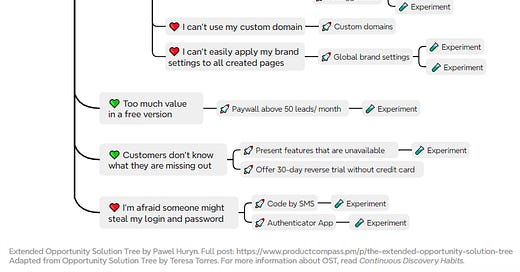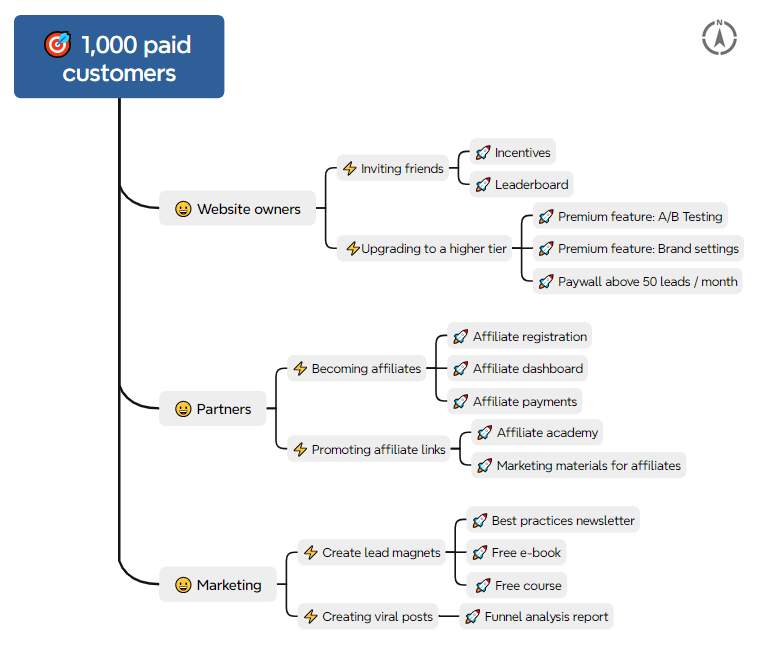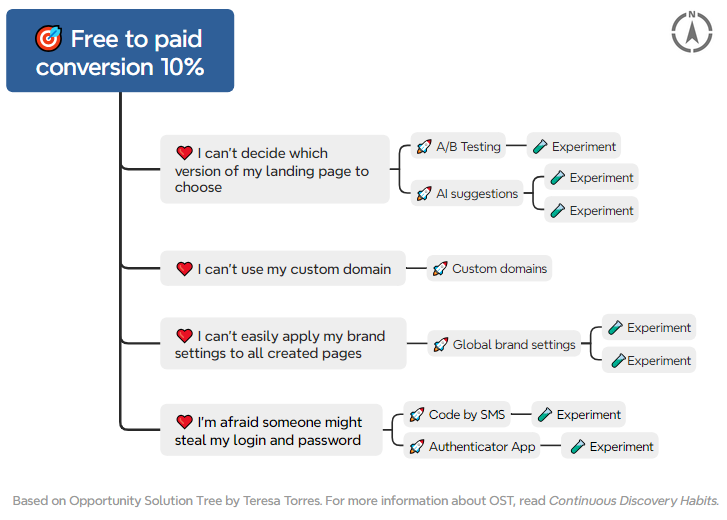The Extended Opportunity Solution Tree
Case Study: Capturing value for the business. What can Product Managers learn from Impact Mapping?
Hey, Paweł here. Welcome to the premium edition of The Product Compass.
Each week, I share actionable tips and resources for product managers.
Not a subscriber yet? Here are a few posts you might have missed:
Assumption Prioritization Canvas: How to Identify And Test The Right Assumptions
Kano Model: How to Delight Your Customers Without Becoming a Feature Factory
Also, see 85+ posts in the archive.
Consider subscribing and upgrading for the full experience:
The Opportunity Solution Tree by Teresa Torres is a fantastic approach that I’ve been recommending for many years. I believe every Product Manager should know it by heart.
Teresa’s book Continuous Discovery Habits is the #1 book on Continuous Product Discovery. After all, she popularized the term!
At the same time, every product serves two purposes:
Creating value for the customers.
Capturing value for the business.
While the Opportunity Solution Tree is an excellent tool for teams focused on the former (most customer-facing product teams), it doesn’t help you analyze the latter.
And that’s not a disadvantage; it just wasn’t designed for this.
So, in today’s newsletter, I want to share a case study based on my experience and demonstrate how to combine the Opportunity Solution Tree with Impact Mapping:
Case Study Background
Impact Mapping Step-By-Step
Opportunity Solution Tree Step-By-Step
🔒 How to Combine Impact Mapping With the Opportunity Solution Tree
🔒 Conclusion
1. Case Study Background
Lead Magnet is a SaaS product designed to help small and medium organizations capture leads easily using pre-built landing page templates and an intuitive drag-and-drop designer.
Unlike many competitors, it offers a free plan for up to 200 monthly leads.
Currently, only 2% of users upgrade from free to paid—just 200 out of 10,000 customers.
Our goal is to have at least 1,000 paying customers.
2. Impact Mapping Step-By-Step
First, let’s find a solution using the Impact Mapping technique introduced in Gojko Adzic's Impact Mapping.
2.1 What is Impact Mapping?
Impact Mapping is a popular Agile technique. This approach starts with a goal and digs deeper through four levels to identify what to build:
🎯 Goal (WHY): A SMART (specific, measurable, achievable, relevant, and time-bound) goal. According to Gojko Adzic, for commercial products, we should “try to define goals that have an obvious link to money.” Importantly, the goal should focus on the problem, not the solution.
😀 Actors (WHO): People or groups who will help us achieve our goal. These might include specific customer segments, internal departments, partners, etc., who are impacted by our changes, assist in reaching our goals, or even act as detractors.
⚡ Impacts (HOW): The desired changes in the actor’s behavior that we believe will help us achieve our goal.
🚀 Deliverables (WHAT): The specific feature ideas or other deliverables that will cause or help actors change their behaviors.
2.2 Impact Mapping Example
In our case study, the Impact Map could look like this:
Impact Mapping gives us a broad overview. We identified impacts and deliverables not only for our customers but also for other key actors, such as:
Partners and the affiliate program we want to promote.
Actions and deliverables that need to be developed by Marketing.
But we’re missing two critical elements from Continuous Product Discovery:
A connection between feature ideas and customer problems, needs, and desires (Opportunities). We risk missing important insights without understanding how specific features address them and without deep customer empathy.
Identifying and testing assumptions. This is a significant gap because most of our product ideas won’t work as expected. You can’t just select your deliverables for implementation.
3. Opportunity Solution Tree Step-By-Step
Let’s analyze the same problem using the Opportunity Solution Tree, as described by Teresa Torres in Continuous Discovery Habits.
3.1 What is Opportunity Solution Tree
I’ve described the Opportunity Solution Tree many times, for example, in What Is Product Discovery, and explained how The Product Trio collaborates in Product Trio: Beyond the Obvious.
So, to keep it brief, this approach starts with a desired product outcome and digs deeper through four levels:
🎯 Desired Product Outcome: Unlike a business outcome, the product outcome is an outcome that a specific product team can directly influence. It’s related to a change in human behavior, so it’s closest to an impact from Impact Mapping.
💖 Opportunities: Those are customers’ problems, needs, and desires that we believe, when addressed, will help us achieve our desired product outcomes.
🚀 Ideas: Specific features that address the identified Opportunities.
🧪 Experiments: We need to identify and test selected assumptions to address selected product risks before implementation.
This approach results in a validated Product Backlog.
3.2 Opportunity Solution Tree Example
In our case study, the Opportunity Solution Tree might look like this (I used a layout different than you might be used to, but more suitable for taking a screenshot):
Focusing on exploring the problem space and empathizing with customers allowed us to identify opportunities that might otherwise have been missed, such as:
Customers want to use their custom domains.
Customers are worried that someone might get unauthorized access to their accounts.
Additionally, understanding customers’ problems led us to uncover new feature ideas:
AI suggestions for landing page design.
We also identified assumptions related to value, usability, viability, and feasibility. We will perform experiments to test selected assumptions before moving forward with implementation.
Unfortunately, we overlooked an important business issue: there’s too much value in the free version and too little in the paid version.
And in the Impact Mapping, we previously suggested:
Solving specific problems only in a paid version (e.g., A/B Testing).
Changing the limit of monthly leads in a free version from 200 to 50.
Why did it happen?
The Opportunity Solution Tree focuses solely on the customer value. It doesn’t help you discover how to capture value for the business. And that’s not a disadvantage; it just wasn’t designed for this.
4. How to Combine Impact Mapping With the Opportunity Solution Tree
Before we dive into how to combine the best aspects of Impact Mapping and the Opportunity Solution Tree, let’s first look at their differences:
Keep reading with a 7-day free trial
Subscribe to The Product Compass to keep reading this post and get 7 days of free access to the full post archives.





